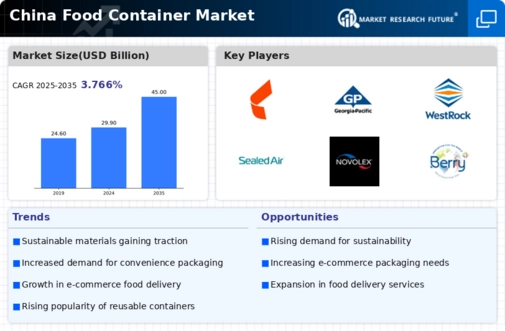Rising Urbanization
The rapid urbanization in China is a pivotal driver for the food container market. As more individuals migrate to urban areas, the demand for convenient food storage solutions increases. Urban lifestyles often necessitate on-the-go meal options, leading to a surge in single-use and reusable food containers. According to recent data, urban areas in China are projected to house over 60% of the population by 2030, which could significantly boost the food container market. This trend indicates a shift towards more compact and efficient food storage solutions, catering to the needs of busy urban dwellers. The food container market must adapt to these changing consumer preferences, focusing on products that offer convenience without compromising quality.
Environmental Regulations
The implementation of stringent environmental regulations in China is significantly impacting the food container market. As the government enforces policies aimed at reducing plastic waste, manufacturers are compelled to innovate and adopt sustainable practices. This regulatory landscape is pushing the food container market towards the development of biodegradable and recyclable materials. Recent statistics indicate that the market for eco-friendly food containers is expected to grow by over 20% in the next five years. Companies that proactively align with these regulations may gain a competitive edge, appealing to environmentally conscious consumers. Thus, the food container market is likely to evolve, focusing on sustainability as a core value.
Technological Advancements
Technological advancements are playing a crucial role in shaping the food container market. Innovations in materials and design are leading to the development of containers that are not only more durable but also more functional. For instance, the introduction of smart containers that can monitor food freshness is gaining traction among tech-savvy consumers. Market analysis indicates that the integration of technology in food storage solutions could enhance user experience and convenience. The food container market is likely to see increased investment in research and development to create products that leverage these advancements, thereby attracting a broader consumer base. This trend suggests a future where food containers are not just storage solutions but also smart tools for managing food.
Health and Safety Awareness
In recent years, there has been a marked increase in health and safety awareness among Chinese consumers, which is influencing the food container market. Consumers are increasingly concerned about food safety, leading to a preference for containers made from non-toxic, BPA-free materials. This shift is reflected in market data, which suggests that the demand for safe and hygienic food storage options is rising. The food container market is responding by innovating products that meet these safety standards, thereby enhancing consumer trust. Furthermore, the emphasis on health-conscious living is likely to drive the demand for containers that support meal prep and portion control, aligning with the growing trend of healthy eating.
Changing Consumer Lifestyles
The evolving consumer lifestyles in China are a significant driver for the food container market. With an increasing number of individuals prioritizing convenience and efficiency, there is a growing demand for versatile food storage solutions. The rise of meal delivery services and the trend of home cooking are influencing consumer preferences, leading to a surge in demand for containers that cater to these needs. Market data suggests that the food container market is witnessing a shift towards products that offer multifunctionality, such as containers that can be used for both storage and serving. This adaptability is likely to resonate with consumers seeking practical solutions that fit their dynamic lifestyles.




















Leave a Comment